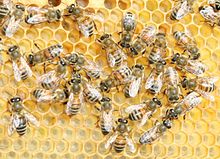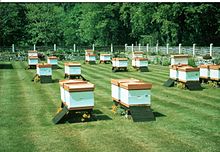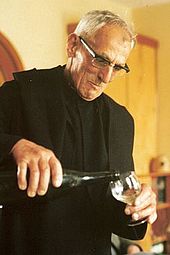Buckfast bee
The Buckfast bee is a crossbreed of the Western honey bee ( Apis mellifera ), which was bred by Brother Adam , a beekeeper, in the English monastery of Buckfast from 1916.
Emergence
In 1913 the European dark bee ( A. m. Mellifera ), which was originally native to the British Isles, was almost completely wiped out by a bee death. The tracheal mite was officially identified as the cause . Recent findings hold caused by this mite virosis likely. Brother Adam then began with the surviving bee colonies (hybrid bees of the dark bee and Italian bee , A. m. Ligustica ) to breed a cross that was supposed to be more resilient, hardworking and peaceful. To do this, he crossed leather-brown Italian bees with drones from the native dark bee. Later he started the systematic crossbreeding of other bee races.
The result is a peaceful, swarming bee that brings above-average yields when using modern farming methods ( magazine prey in Dadant or Langstroth dimensions when arranged in pairs). Successful beekeeping with Buckfast bees, however, is not tied to these special types of hive, as their keeping in today's widespread zander hive shows.
breed
Conventional breeding of natural bee breeds
The beekeeper (beekeeper) breeds the honey bee within a natural bee breed exclusively through pure breeding. Here be queen bees always drones mated the same breed of bees specifically and according to predefined, breed typical physical characteristics and properties (breeding goal) is selected. The natural bee races can be distinguished by their color and certain body features (e.g. wing veins of the fore and hind wings).
In contrast to conventional beekeeping, Brother Adam also used other breeding methods (crossbreeding) to achieve his breeding goals, which in nature only occur in the border areas of the different habitats of two bee races.
Because of the complicated mating biology of the honey bee (queen and drone mate in flight, the queen can be mated by up to 30 different drones), mating takes place in controlled and protected areas, so-called mating sites . Since the queen and drone each cover several kilometers during the mating flight, land mating sites are considered unsafe with regard to a targeted mating of selected queens and drones. Special high-mountain registration points or island registration points with a corresponding distance from the mainland are considered to be secure. The safest targeted mating is done by artificial insemination of the queen.
The susceptibility of honeybees to inbreeding, with the resulting negative effects on the breeding population, is well known among beekeepers. In pure breeding of honey bees, many bee colonies involved in breeding (broad breeding base) are therefore required in order to avoid inbreeding depression in the long term.
Brother Adam was firmly convinced that the exclusive pure breeding of the honeybees would inevitably lead to inbreeding problems and “genetic erosion” within this breed. He found a solution to this problem in the scientific work of Ludwig Armbruster . Here a breeding method was shown which, in compliance with the laws of inheritance, led to a new, artificially bred bee breed (breeding breed), the Buckfast bee .
Dynamic breeding process
In addition to the use of other breeding methods, Buckfast breeding, compared to conventional beekeeping, completely dispenses with the definition of breed-typical body characteristics (hair on the beehive, wing index). The Buckfast bee is only defined by its beekeeping properties. Color differences and various body features are breed-related and are not a selection criterion.
The dynamic breeding process developed by Brother Adam includes the possibility of unlimited further breeding of the Buckfast bee without loss of vitality in the bee colonies. The breeding process follows the inheritance laws that are also applicable to the breeding of honeybees in order to achieve a “hereditary” breeding breed.
The dynamic breeding process consists of three breeding methods:
- Pure breeding (maintenance breeding)
- Crossbreeding (crossing of the Buckfast bee with a natural, alien breed of bees)
- Combination breeding (test breeding conducted in parallel, often continued over several years)
Buckfast breeding is based on the pure breeding (pairing of Buckfast queens with Buckfast drones) Buckfast strain with different breeding lines (designation B1, B2, B3 etc., where "B" stands for Buckfast and the number is the box number in which one certain queen bee is sitting with her colony).
In parallel to the Buckfast line, separate crossbreeds (crossbreeding) are carried out (pairing of a selected breed of the western honey bee with the Buckfast bee). Over the years, selected bee races from all parts of the world have been tested and partially crossed into this newly created Buckfast : Cypriot bee ( A. m. Cypria ), Carinthian bee ( A. m. Carnica ), southern Greek bee ( A. m. cecopria ), Anatolian bee ( A. m. anatolica ), Macedonian bee ( A. m. macedonica ) from Athos and the Egyptian bee (A. m. lamarckii). Not all of these matings were permanently anchored in the Buckfast breed, so the A. m. carnica and also the A. m. cypria left again.
These crossbreeds are subsequently continued in combination breeding parallel and separately to the Buckfast line. There is always a mating with the breeding lines of the Buckfast line or with other breeding lines of the combination breeding. Only when, after several years of testing and selection, the combination breeding lines correspond in their properties, they are incorporated into the Buckfast line.
Breeding always requires careful examination of the breeding results and an uncompromising selection of the breeding animals. As soon as a loss of certain characteristics or a loss of vitality can be determined in a Buckfast line selected in pure breeding (breeding line within the Buckfast line), new blood and thus an improvement in characteristics is added by incorporating a parallel breeding line in combination breeding.
The Buckfast bee is available to beekeepers in Germany from the Buckfast regional associations or Buckfast breeders. Queens are also offered in trade journals. Especially economically oriented beekeepers (professional and professional beekeepers) like to keep the Buckfast bee. The Buckfast bee is bred worldwide using the method developed by Brother Adam.
In a large-scale study by the Ludwig Maximilians University in Munich , DNA studies on the biodiversity of 2440 Buckfast individual bees from different breeders were compared with Carnica and Ligustica bees. Martin Förster had used 62 DNA markers and concluded:
"Simply put, this means: bees are too good to be impoverished in pure breeding, because increased genetic diversity protects the bees and our common environment."
Relation Buckfastbiene and Carnica
In Germany and Austria, keeping the Buckfast bee was and is not undisputed. In these two countries, hobby beekeepers now predominantly keep and breed another breed of bees , the Carinthian bee ( A. m. Carnica ). Carnica was imported from Carinthia and Slovenia into the entire German-speaking area in the 20th century, where it displaced the native bee Apis mellifera mellifera . Some beekeepers see the introduction of Buckfast bees as a threat to the pure breeding of their breed. More recent scientific studies that were carried out worldwide between 2003 and 2013 suggest, however, that bee colonies with a queen who has mated with as many genetically different drones as possible stand out due to important properties such as higher productivity, higher fitness, generally reduced susceptibility to disease and greater chance of survival. Due to the honeybees' special mating behavior, true pure breeding will only be possible in specially protected areas (mating sites ) or through artificial insemination of the queens as soon as different bee races are present in one area . According to observations by Buckfast bee breeders, the crossbreeding of the two breeds, which inevitably occurs in many areas today, does not have an excessive tendency to stinging, as is the case for example. B. in the 1960s when the so-called landrace (largely still A. m. Mellifera ) was converted to Carnica.
In Carinthia , however, there were violent disputes between commercial and recreational beekeepers over the Carinthian Beekeeping Act of July 5, 2007, which regulates the keeping, migration and breeding of bees that do not belong to the "Carnica" breed (Apis mellifera carnica) by a ( usually not granted) approval of the state government. In 2015 there were reports against and voluntary reports by beekeepers in order to achieve a change in the law. The chairman of the professional beekeepers argued: “The beekeeping law requires pure breeding of Carnica and 95 percent of pure breeding of Carnica is not available in Carinthia.” The chairman of the regional association of Carinthian beekeepers, Meinhard Schöffmann, argues against it: “Straight from the Those who are responsible for ensuring that we have hybridized bees in Carinthia will now be reported to those who are trying to preserve Carnica in Carinthia. ”Despite the disputes, the Carinthian Beekeeping Act is still in force in its current form . In neighboring Styria , the state government is planning to relax the regulations.
Individual evidence
- ↑ Bieneninstitut Kirchhain data sheet: Viruses of bees ( Memento from February 8, 2015 in the Internet Archive ) (PDF file)
- ↑ Notes on the breeding, maintenance and further development of the Buckfast bee
- ↑ DNA studies on the biodiversity of Buckfast bees, Martin Förster, Ludwig Maximilians University Munich, Der Buckfastimker February 2011
- ↑ Die Biene 1/2014 pp. 22–24
- ↑ Carinthian Beekeeping Act of July 5, 2007.
- ↑ Beekeepers want to overturn the beekeeping law , ORF.at, July 12, 2015.
- ^ "Bee war": Greens strengthen the Carnica front , krone.at, November 3, 2018.
literature
- Ludwig Armbruster : Beekeeping Science . Theodor Fischer Berlin 1919 (reprinted by Ertl & Ertl, Vienna 2003)
- Brother Adam : Looking for the best beehives. C. Koch Verlag, Oppenau, ISBN 3-9800797-0-8
- Brother Adam: My way of working: Successfully beekeeping as in Buckfast Monastery. Verlag C. Koch, Oppenau ISBN 3-440-09185-6
- Brother Adam: Breeding the honey bee. Beekeeping Technology Verlag, Oppenau, ISBN 978-3-9800797-5-4 .
- Friedrich Ruttner : Breeding technology and breeding selection in the bee . Franckh-Kosmos Verlag, 1996.




